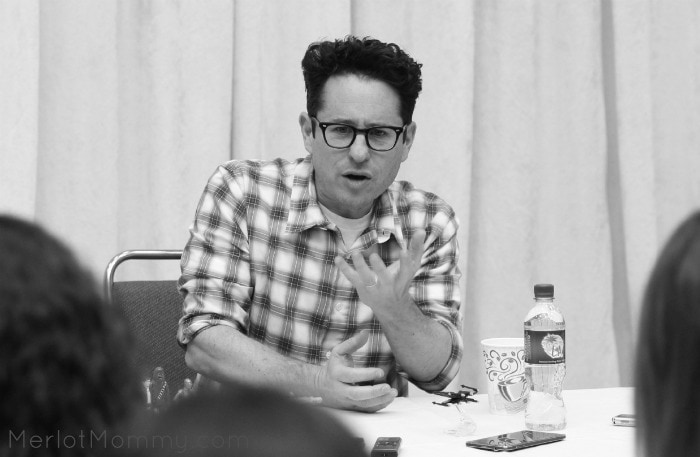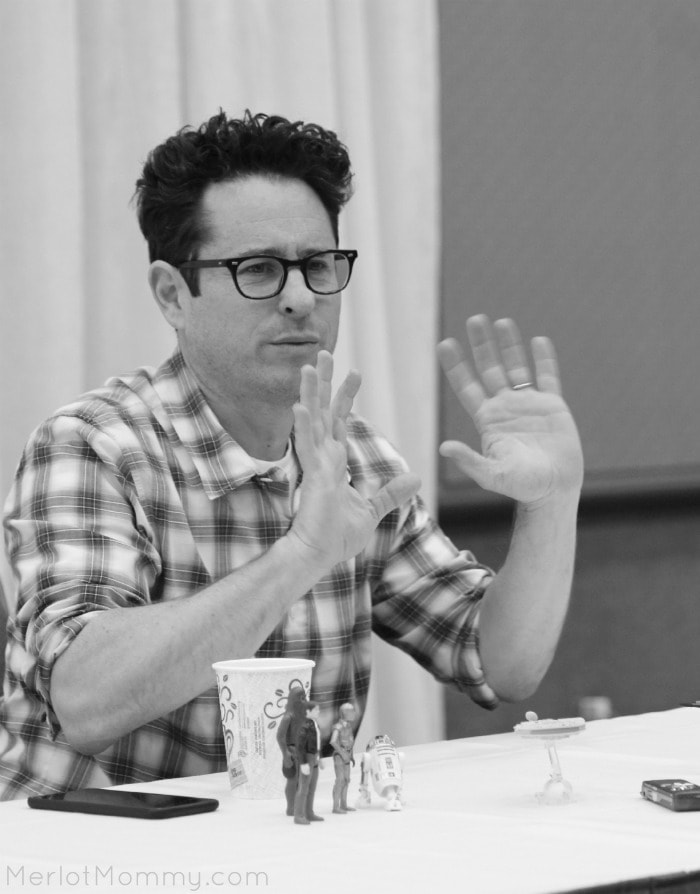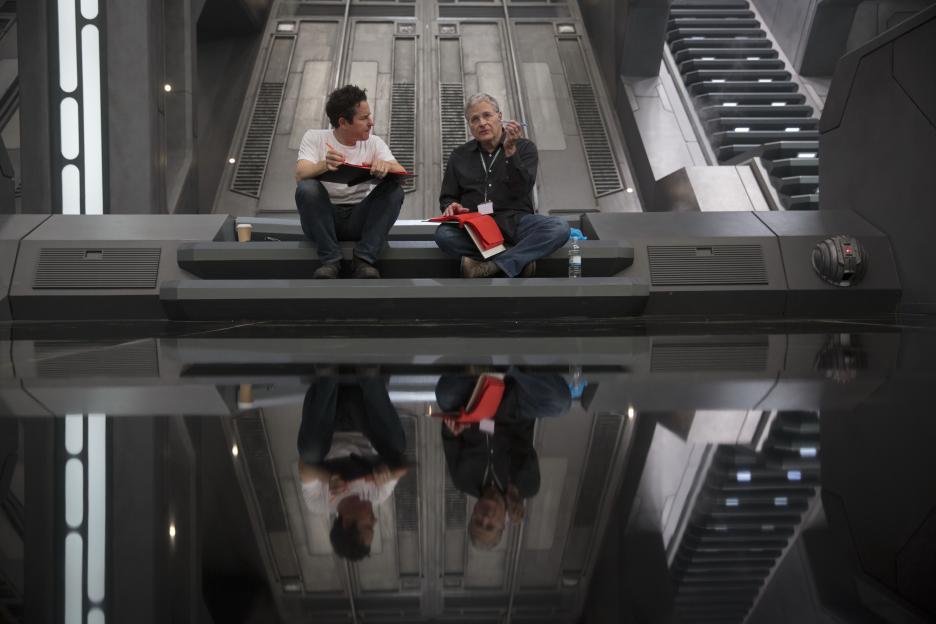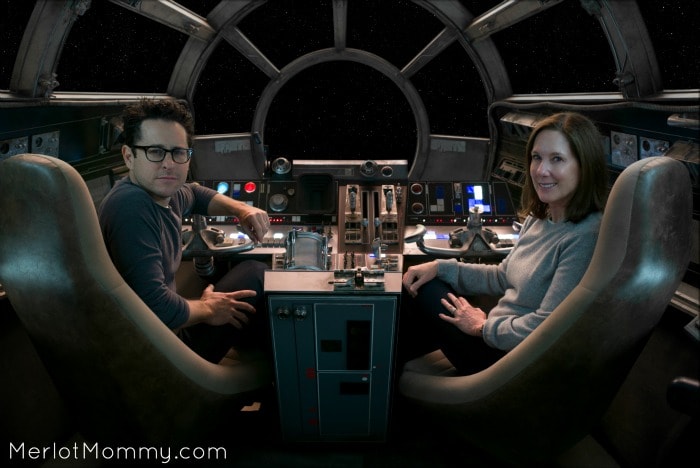Here’s part 1 of an exclusive interview with J.J. Abrams
I’m a HUGE J.J. Abrams fan. So when I heard he was going to be part of the interviews for the press junket/press conference for Star Wars: The Force Awakens playing in theatres now (you can read my review here), I was a giddy fan girl inside. J.J. Abrams! The man’s work includes some of my favorite television shows and some great movies: Felicity, Alias, Lost, Person of Interest, Mission Impossible: Ghost Protocol, and so many more. It was one of the most amazing interviews I’ve had, and I’ve had the pleasure to interview a lot of cool and wildly talented people over the years.
Of all the press junket interviews I’ve done, this was the first where we didn’t screen the film first, and because there was so little out about the movie, it made coming up with questions somewhat challenging. However, it IS J.J. Abrams, so if you can’t think of questions to ask J.J. Abrams, regardless of whether or not you’ve seen the movie, you are in the wrong profession.
Our interview with J.J. Abrams was fun. His storytelling skills come through just in his recounting of things such as his encounter with Lin-Manuel Miranda at the theatre. He’s kind of like a nearly 50-year-old kid, but more mature than that; all the best qualities if you could combine the creativity of a child with the diligence and maturity of an adult. He was engaged, interested, and despite the fact that it was at the tail end of a REALLY long day for all of us, even when the end of our time slot was up, and our last question warning was given, J.J. Abrams said, “We can do a couple more, right? Let’s do like two more questions.” Which turned into four longs ones, one short one, and 12 minutes, nearly doubling our interview time. Clearly he liked us as much as we liked him. This is why I’ve broken this up into two parts: I want you to be able to experience all of the 25 minutes we had we J.J. if you want to.
Read on to see what J.J. Abrams had to tell us about working with Lin-Manual Miranda, the use of puppetry, and on being a part of the Star Wars universe.
This post contains affiliate links, meaning that when you click on a link that we recommend, we may receive a teeny weeny commission if you purchase a product. We wouldn’t be doing our job to pay the bills if we didn’t monetize somehow!
Oh, you know when J.J. Abrams looks right at you to answer your question (photo courtesy of momstart.com)
On that fact that he wasn’t even 11 years old when the first Star Wars came out and if that influenced how he approached the film
J.J. Abrams: I’m sure it did, because it was something that meant so much to me for so long. The thing is that it’s because it’s been engrained in sort of all of our conscientiousness for so long, it’s become a birthright to just know Star Wars. You know what a lightsaber is, Darth Vader, you understand that. At 3 years old, kids talk about Star Wars in a way that is so eerie, ’cause you think,”How could you possibly know so much?” And somehow they do, and even those kids who haven’t played the games or seen the shows, I don’t know how it is that they understand Star Wars
immediately.
But my job wasn’t to be a fan boy or an 11-year-old kid. It was to be a nearly 50-year-old movie director, so I tried to approach this thing from a point of view of obviously acknowledging how much I love what George Lucas created, but understand that being a fan doesn’t make the story work. Being a fan doesn’t make the scene any good. Being a fan is great, but we all had to be storytellers and filmmakers.
I was surrounded by people like Lawrence Kasdan, who’d written the Empire Strikes Back and Return Of The Jedi
, and actors who had been there from the beginning, all the way through visual effects and sound of course John Williams, who collaborating with him is like cheating, ’cause he speaks to our soul with music in a way that I think is super-human. So the whole process was really about trying to love it but also be hard on it, so that the story meant something and was emotional and not just a fan film.
On collaborating with Lin-Manuel Miranda
J.J. Abrams: My 17-year-old son and I went to see Hamilton, which if you haven’t seen it, is one of the great experiences of all time, which cannot be oversold. And you hear crazy hyperbolic language being used about it, and then you go to see it, and it’s better than anyone described it, and gets better as it goes, which is impossible. At intermission, I was thinking it can’t possibly continue at this level, and it just gets better.
And then I was distracted at intermission by a tap on my shoulder and I turned around it was Lin-Manuel Miranda, who normally stars in this thing he wrote, and wrote the songs for, but this night it was his understudy. And said,”Hi.” And I was like, “Oh, my God. Do you understand what you’ve done?” He’s like, “Yes.” And I was essentially fawning over him, and he said in this jokey, off-hand way, “If you need music for the Cantina, I’m happy to do it.” And it was so weird because a couple weeks earlier, John Williams, had said to me he really wanted to focus on the score. There’s a lot of music in the movie.
And he said this one scene in the, in the film, which is essentially, if we have a version of a kind of cantina scene, if someone I work with said Star Wars is a Western, there’s a sort of a saloon in every Western, and this was our saloon. And John said, “You know, I’d rather not work on this music because I have so much other score to do, and this is really source music.” I was like, alright. I thought,”Crap, what are we gonna do?” And I started working on something as sort of a hobbyist musician myself.
So I was working on a piece of music. Anyway, Miranda says this to me, I can’t believe it. So I email Lin and I say, “Listen, I know you were joking, but the truth is we sort of have a need for some music in the scene, if you’re serious.” And he emails back. He’s like, “I’ll drop everything.” I’m like, “Oh, my God. You’re kidding me.” And so we started collaborating on this music, and we both use the same music software, and we have Dropbox, and we would send files back and forth. And we came up with this piece of music, actually two pieces of music for this sequence, and to get to work with him was preposterously fun.
And I, I got to hang out with him subsequently, and if you haven’t seen his appearance on Jimmy Fallon, it’s one of the greatest things you’ve ever seen because it’s freestyle rap, which is actually, truly unprepared in any way, and staggering. He is amazing.
On how he felt when he was first asked to be a part of the Star Wars universe
J.J. Abrams: Kathleen Kennedy, who I’ve known for a long time, she called and asked if I was interested in working on Star Wars. And, of course, you know, it was a very surreal question, and it was very flattering. And my answer was no, partly because, Katie, my wife, and I had plans to take our kids away. I’d been working on a lot of back-to-back, projects for a while, partly because I’d worked on a number of sequels, and it felt like enough is enough, and partly because I care about Star Wars so much that the idea of taking it on felt like a kind of a thing that I couldn’t imagine, and intimidating.
And so I said no thank you, and she said can we get together. I said yes. And when Kathy Kennedy and you get together, she’ll convince you of whatever it is she wants you to. And she just was amazing and basically said this was going to be an opportunity to continue the story since Return Of The Jedi. As we were talking, I realized this is 30-some years after the fact, the main characters would have been born 10-to-15 years after that movie.
Looking back on what we know of the story, that would be ancient history for kids who were 19, 20 years old. What do they know? What do they believe? And what do they believe in? And the idea of finding these young people who exist in a Star Wars universe was so compelling to me, and that feeling of re-discovering a world and a feeling that was so powerful for growing up was undeniable. After the meeting, I went downstairs and found Katie and said I think I really want to do this.
And she said, “Really?” I said, “Yes.” And she said, “You know, this is definitely a once in a lifetime opportunity. And you really need to consider if this is something you want to do.” And I did and it wasn’t an easy for us, for our family, for my company, Bad Robot.
There were a lot of issues that came with it and yet I knew that as challenging as it would be that if we could all get our sea legs and do it right, that it could be an extraordinary situation and an amazing experience, and in every category from prep and figuring out the story and writing the script with Lawrence Kasdan and designing the movie shooting it and editing it and doing post and scoring it.
And, I mean, literally through the 3D pass, the reviews that we’ve had—and I’m not always the biggest 3D fan, but I will tell you there are things in this movie that I actually felt were shockingly better in 3D, because there are literally shots that I couldn’t believe I saw things in 3D that I hadn’t seen in 2D; it was so strange. I know this might sound like I’m selling the 3D, and to anyone who doesn’t really care, see it in 2D. Don’t see it in 3D, you know. It’s okay.
I was amazed at how great that looked. Every stage has been as gratifying as it was challenging, and it’s all because of the unparalleled and unbelievable work that everyone did at every turn. And I’m very grateful.
On the use of puppetry
J.J. Abrams: Well, I remember seeing Star Wars and Empire and Jedi, and of course that was before there was such a thing as a CG character. And the use of puppetry was so brilliant and it reminded me, this is so strange, because when we were shooting the scene that I was referring to in the cantina, there were a number of creatures there as well as in other sequences, but a lot in that one scene.
And I remember looking around and there were just puppeteers under every table and poking through things and there were just all these people there were basically invisible, but they were performing these characters and that Neal [Scanlan] and his team created. And I remember feeling like, “Oh, my God. It’s like we’re on the set of a Muppet movie.” And it was so cool and I realized, of course, Frank Oz, and this Venn diagram of what Jim Henson and his workshop did, and what George Lucas did, not only to overlap obviously in Yoda, but that there was a kind of creative, home spun, do-it-yourself genius that was when the Muppets were brought to life they were playing these sort of often plush, comedic characters.
And George Lucas used the same technology to create what appeared to be living, breathing flesh and blood characters. And it was so wonderful to have that, and as the shoot continued, the biggest advantage was in BB-8, who is our new droid, who in scenes with the other actors, Daisy [Ridley] and John [Boyega] and Harrison [Ford], this droid was alive, was expressive, passionate, curious, helpful, afraid, daring.
He was literally on camera, in scenes doing everything that you could have ever dreamed of. We could have worked with our extraordinary, computer graphics department, at I.L.M. and made that work, but it never would have looked quite as good, quite as real, and Daisy, who is now starring in her first movie and is fearless and sweet and vulnerable and tough and a revelation, in this movie.
To have her interact with BB-8, performed by Brian and David, Brian always right there next to him, so off and on camera, David with the remote control off camera. And we use CG for BB-8
not to bring BB-8
into the shot but to remove the puppeteers. So we use CG quite a bit to actually get rid of legs poking out from the bottom of a creature, wires, rigs, arms, and stuff like that, but it was really an amazing thing to have all those creatures and BB-8—the most important one—live and present and in the frame and in the shot.
So that when there where CG creatures, when there were things that we couldn’t do physically, there was a standard to match, which was actually captured on film.
(read part 2 here)
STAR WARS: THE FORCE AWAKENS is now playing in theatres everywhere
 I’ve been invited to LA courtesy of Disney for a media event. All opinions are my own.
I’ve been invited to LA courtesy of Disney for a media event. All opinions are my own.
- Finding Calm in the City That Never Sleeps - September 24, 2025
- Different Reasons to Consider Using a Therapist in New York - March 12, 2025
- Is a Micro Wedding the Dream You Didn’t Know You Had? - February 14, 2025











How cool! We are going to see the movie this Sunday! Can’t wait!
The cookies are adorable I’ve gotta try those!